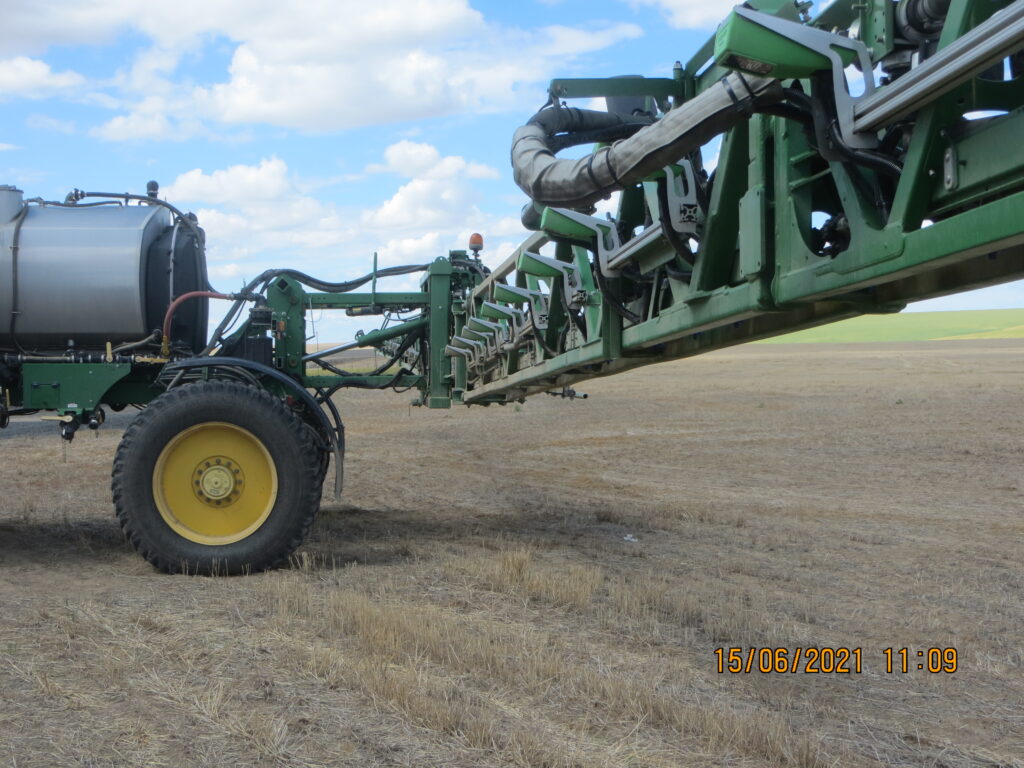By Ian Burke and Aaron Esser
Change often happens slowly on the farm, particularly in areas where wheat-fallow rotations are practiced. The margins are too thin to risk significant change. A new variety, perhaps, or an autosteer system. Management of weeds with herbicides, in particular, has been essentially unchanged since we started using Roundup back in the 1970s. Different mixtures have been used, but the application equipment and the basic philosophy are the same—inexpensive herbicides applied through a broadcast sprayer when the weeds are bigger than they really should be. That approach is very quickly becoming obsolete because of a new generation of optical sensor sprayer systems.
Sensor systems aren’t a new idea, but they have most definitely evolved. The very first systems developed in the early 1990s were able to detect weeds and spray them, but they were challenging to use, didn’t work well in fields with soil or residue variation and required constant calibration. The very first system was called Detectspray. It relied on ambient light and was prone to error as a consequence, but was still capable of reducing overall herbicide use compared to broadcast applications.
The next system was called WeedSeeker, which was equipped with LED lights operating in the near infrared. With its own light source, the WeedSeeker could operate in a greater range of conditions, but still required the operator to clear an area of green vegetation for calibration—a challenging task on a boom that might extend 100 feet. And if the residue or soil color changed, the system had to be recalibrated. Needless to say, although a few such systems were acquired by a few farmers, researchers and organizations in the Pacific Northwest, they were not widely adopted.
The most recently introduced systems are something different, though. And there are now choices—WEED-IT, the WeedSeeker 2 or the See and Spray system are currently the most easily obtainable, but more are coming. Each system has a unique system design, and the See and Spray system uses real time image analysis. The See and Spray system can selectively detect weeds in crop, while the WEED-IT and WeedSeeker 2 spray anything green. As a consequence, there are performance differences because of those approaches and differences in cost. But they work, are easy to use (a very important attribute!) and are robust enough to survive life on the farm.
By work, we mean they can significantly reduce overall herbicide use without any real sacrifice in weed control. That doesn’t mean that things can’t go wrong. In the course of the last few years working with one system, we’ve learned a great deal about how and also how not to use an optical sensor sprayer.
The first lesson we learned was about rate and plant population. The most obvious tactic a farmer might attempt is the use of higher herbicide rates in the optical sensor sprayer system. We have found that approach to potentially cut both ways. Yes, higher rates can improve control. However, if you drive an optical sensor sprayer into a particularly weedy patch, the cost to treat that patch can very quickly exceed the cost of a typical broadcast treatment if the rate applied is too high.
We settled on a breakeven threshold system based on the cost of the herbicide we were using and the percent area treated. The cost of herbicides varies widely, as do weed population densities. An inexpensive herbicide like glyphosate, which has a wide range of rates that can be used to treat the acre, can have a break-even threshold well below 15 percent of the broadcast application cost—at the normal broadcast rate.

Another issue we discovered is that using herbicides that take time to kill can cause issues when that area is retreated. Certain weeds like prickly lettuce, Russian thistle and tumble mustard can remain green long after treatment, and green enough to be retreated when the optical sensor sprayer system detects the weed again.
After using our sprayer for several seasons, it’s clear that the use of optical sensor sprayer systems will require a fundamental change in philosophy around managing weeds in fallow with herbicides.
Instead of waiting, the real savings with a such a tool will be achieved by using it early and more often. The new generation of weed sensing sprayer systems detect small weeds, and those small weeds die faster. The next pass will pick up newly germinated weeds, so there’s no need to wait for more weeds to germinate. Waiting is counterproductive when using a weed sensing sprayer—use it earlier and a little more often.
There’s minimal need to use higher rates when spraying small weeds, minimizing the risk of overuse and the resulting increase in cost. We found that Sharpen, in particular, fit well as a mixture partner with glyphosate to speed weed death. Using mixtures of herbicides at normal rates is an effective approach and a good integrated pest management practice, rather than using higher rates of one herbicide.
If higher rates are of interest, know your weed population density. Even a moderately weedy field—a field that appears green as you drive by—likely has a very low percent area covered by weeds. We have found that anything more than about 25 to 30 percent weed cover is likely best treated with an equivalent broadcast rate, rather than an elevated rate.
The use of a preemergence herbicide in the fall, at the start of the fallow rotation, can significantly reduce the overall weed population and thus the use of postemergence herbicides through the optical sensor sprayer. Coupling a preemergence herbicide program with an optical sensor sprayer system can significantly reduce overall postemergence herbicide applied using the optical sensor sprayer.
And if you don’t use a preemergence herbicide, these systems may also have a very good fit with postharvest weed control where weed populations in stubble are too low to justify a broadcast herbicide or sweep-plow tillage operation.
Optical sensor sprayer systems are well documented to reduce overall yearly herbicide costs, when careful attention is given to which herbicides are used and when they are applied. Even the earliest systems were capable of reducing overall herbicide use by 70 percent, and our experience is no different. In our experiments, herbicide use was reduced 40 to 95 percent.
The optical sensor sprayer systems available today are the first really transformative robotic technology capable of significantly altering the cost of production. The systems are expensive. They should not be viewed as an additional sprayer, but as the primary sprayer. These systems are highly capable pulse width modulation broadcast sprayers and can be used for general purpose sprayer work with the right nozzles.
As more are purchased and deployed in the region, overall herbicide use will likely decline significantly, and that’s a real achievement and great step toward improving the sustainability of our systems.
This article originally appeared in the July 2021 issue of Wheat Life Magazine.

Ian Burke, Ph.D.
Ian Burke holds the J. Cook Endowed Chair of Wheat Research at Washington State University. His research program is focused on basic aspects of weed biology and ecology with the goal of integrating such information into practical and economical methods of managing weeds in the environment. Read more about Dr. Burke.
